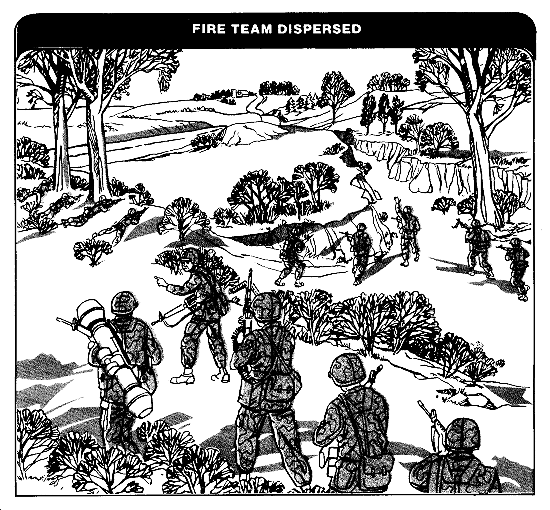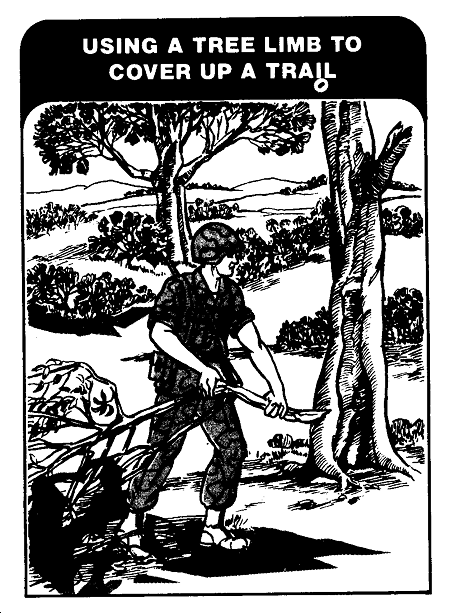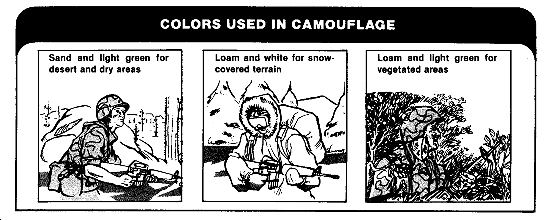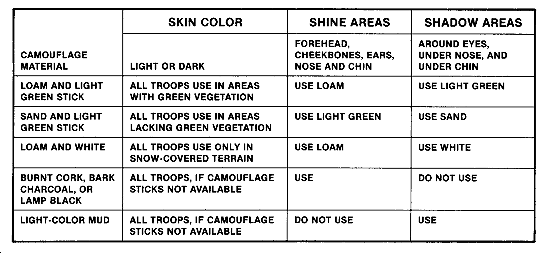CHAPTER 1
Cover, Concealment, and Camouflage
If the enemy can see you, he can hit you with his fire. So you must be
concealed from enemy observation and have cover from enemy fire.
When the terrain does not provide natural cover and concealment, you must
prepare your cover and use natural and man-made materials to camouflage
yourself, your equipment, and your position. This chapter provides guidance on
the preparation and use of cover, concealment, and camouflage.
COVER
Cover gives protection from bullets, fragments of exploding rounds, flame,
nuclear effects, and biological and chemical agents. Cover can also conceal you
from enemy observation. Cover can be natural or man-made.

Natural cover includes such things as logs, trees, stumps, ravines, and
hollows. Manmade cover includes such things as fighting positions, trenches,
walls, rubble, and craters. Even the smallest depression or fold in the ground
can give some cover. Look for and use every bit of cover the terrain offers.
In combat, you need protection from enemy direct and indirect fire.
To get this protection in the defense, build a fighting position (man-made
cover) to add to the natural cover afforded by the terrain.

To get protection from enemy fire in the offense or when moving, use routes
that put cover between you and the places where the enemy is known or thought to
be. Use ravines, gullies, hills, wooded areas, walls, and other cover to keep
the enemy from seeing and firing at you. Avoid open areas, and do not skyline
yourself on hilltops and ridges.

CONCEALMENT
Concealment is anything that hides you from enemy observation. Concealment
does not protect you from enemy fire. Do not think that you are protected from
the enemy's fire just because you are concealed. Concealment, like cover, can
also be natural or man-made.
Natural concealment includes such things as bushes, grass, trees, and
shadows. If possible, natural concealment should not be disturbed. Man-made
concealment includes such things as battle-dress uniforms, camouflage nets, face
paint, and natural material that has been moved from its original location.
Man-made concealment must blend into the natural concealment provided by the
terrain.

Light discipline, noise discipline, movement discipline, and the use of
camouflage contribute to concealment. Light discipline is controlling the use of
lights at night by such things as not smoking in the open, not walking around
with a flashlight on, and not using vehicle headlights. Noise discipline is
taking action to deflect sounds generated by your unit (such as operating
equipment) away from the enemy and, when possible, using methods to communicate
that do not generate sounds (arm-and-hand signals). Movement discipline is such
things as not moving about fighting positions unless necessary, and not moving
on routes that lack cover and concealment. In the defense, build a
well-camouflaged fighting position and avoid moving about. In the offense,
conceal yourself and your equipment with camouflage and move in woods or on
terrain that gives concealment. Darkness cannot hide you from enemy observation
in either offense or defense. The enemy's night vision devices and other
detection means let them find you in both daylight and darkness.
CAMOUFLAGE
Camouflage is anything you use to keep yourself, your equipment, and your
position from looking like what they are. Both natural and man-made material can
be used for camouflage.
Change and improve your camouflage often. The time between changes and
improvements depends on the weather and on the material used. Natural camouflage
will often die, fade, or otherwise lose its effectiveness. Likewise, man-made
camouflage may wear off or fade. When those things happen, you and your
equipment or position may not blend with the surroundings. That may make it easy
for the enemy to spot you.
CAMOUFLAGE CONSIDERATIONS
Movement draws attention. When you give arm-and-hand signals or walk
about your position, your movement can be seen by the naked eye at long ranges.
In the defense, stay low and move only when necessary. In the offense, move only
on covered and concealed routes.
Positions must not be where the enemy expects to find them. Build
positions on the side of a hill, away from road junctions or lone buildings, and
in covered and concealed places. Avoid open areas.

Outlines and shadows may reveal your position or equipment to air or
ground observers. Outlines and shadows can be broken up with camouflage. When
moving, stay in the shadows when possible.

Shine may also attract the enemy's attention. In the dark, it may be a
light such as a burning cigarette or flashlight. In daylight, it can be
reflected light from polished surfaces such as shiny mess gear, a worn helmet, a
windshield, a watch crystal and band, or exposed skin. A light, or its
reflection, from a position may help the enemy detect the position. To reduce
shine, cover your skin with clothing and face paint. However, in a nuclear
attack, darkly painted skin can absorb more thermal energy and may burn more
readily than bare skin. Also, dull the surfaces of equipment and vehicles with
paint, mud, or some type of camouflage material.

Shape is outline or form. The shape of a helmet is easily recognized. A
human body is also easily recognized. Use camouflage and concealment to breakup
shapes and blend them with their surroundings. Be careful not to overdo it.

The colors of your skin, uniform, and equipment may help the enemy
detect you if the colors contrast with the background. For example, a green
uniform will contrast with snow-covered terrain. Camouflage yourself and your
equipment to blend with the surroundings.

Dispersion is the spreading of men, vehicles, and equipment over a wide
area. It is usually easier for the enemy to detect soldiers when they are
bunched. So, spread out. The distance between you and your fellow soldier will
vary with the terrain, degree of visibility, and enemy situation. Distances will
normally be set by unit leaders or by a unit's standing operating procedure
(SOP).

HOW TO CAMOUFLAGE
Before camouflaging, study the terrain and vegetation of the area in which
you are operating. Then pick and use the camouflage material that best blends
with that area. When moving from one area to another, change camouflage as
needed to blend with the surroundings. Take grass, leaves, brush, and other
material from your location and apply it to your uniform and equipment and put
face paint on your skin.

Fighting Positions. When building a fighting position, camouflage it
and the dirt taken from it. Camouflage the dirt used as frontal, flank, rear,
and overhead cover. Also camouflage the bottom of the hole to prevent detection
from the air. If necessary, take excess dirt away from the position (to the
rear).
Do not overcamouflage. Too much camouflage material may actually disclose a
position. Get your camouflage material from a wide area. An area stripped of all
or most of its vegetation may draw attention. Do not wait until the position is
complete to camouflage it. Camouflage the position as you build.

Do not leave shiny or light-colored objects lying about. Hide mess kits,
mirrors, food containers, and white underwear and towels. Do not remove your
shirt in the open. Your skin may shine and be seen. Never use fires where there
is a chance that the flame will be seen or the smoke will be smelled by the
enemy. Also, cover up tracks and other signs of movement.

When camouflage is complete, inspect the position from the enemy's side. This
should be done from about 35 meters forward of the position. Then check the
camouflage periodically to see that it stays natural-looking and conceals the
position. When the camouflage becomes ineffective, change and improve it.
Helmets. Camouflage your helmet with the issue helmet cover or make a
cover of cloth or burlap that is colored to blend with the terrain. The cover
should fit loosely with the flaps folded under the helmet or left hanging. The
hanging flaps may break up the helmet outline. Leaves, grass, or sticks can also
be attached to the cover. Use camouflage bands, strings, burlap strips, or
rubber bands to hold those in place. If there is no material for a helmet cover,
disguise and dull helmet surface with irregular patterns of paint or mud.

Uniforms. Most uniforms come already camouflaged. However, it may be
necessary to add more camouflage to make the uniform blend better with the
surroundings. To do this, put mud on the uniform or attach leaves, grass, or
small branches to it. Too much camouflage, however, may draw attention.
When operating on snow-covered ground, wear overwhites (if issued) to help
blend with the snow. If overwhites are not issued, use white cloth, such as
white bedsheets, to get the same effect.
Skin. Exposed skin reflects light and may draw the enemy's attention.
Even very dark skin, because of its natural oil, will reflect light. Use the
following methods
when applying camouflage face paint to camouflage the skin.


When applying camouflage stick to your skin, work with a buddy (in pairs) and
help each other. Apply a two-color combination of camouflage stick in an
irregular pattern. Paint shiny areas (forehead, cheekbones, nose, ears, and
chin) with a dark color. Paint shadow areas (around the eyes, under the nose,
and under the chin) with a light color. In addition to the face, paint the
exposed skin on the back of the neck, arms, and hands. Palms of hands are not
normally camouflaged if arm-and-hand signals are to be used. Remove all jewelry
to further reduce shine or reflection.
When camouflage sticks are not issued, use burnt cork, bark, charcoal, lamp
black, or light-colored mud.


















